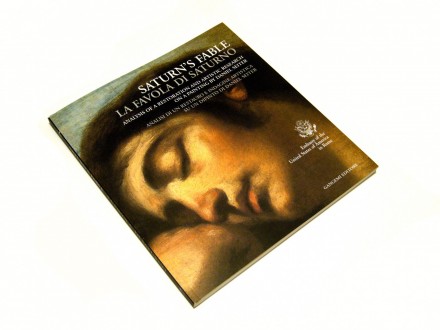Saturn`s Fable. La Favola di Saturno
| Cena: |
| Želi ovaj predmet: | 3 |
| Stanje: | Polovan bez oštećenja |
| Garancija: | Ne |
| Isporuka: | Pošta Post Express Lično preuzimanje |
| Plaćanje: | Tekući račun (pre slanja) Lično |
| Grad: |
Beograd-Zvezdara, Beograd-Zvezdara |
Godina izdanja: 2005
ISBN: 88-492-0848-0
Jezik: Engleski
Oblast: Slikarstvo
Autor: Strani
Valeria Brunori - Saturn`s Fable. La Favola di Saturno
Gangemi, 2005
96 str.
meki povez
stanje: vrlo dobro
22 x 24 cm | Analysis of a restoration and artistic research on a painting by Daniel Seiter / Analisi di un restauro e indagine artistica su un dipinto di Daniel Seiter
english / italian
The Embassy of the United States of America in Rome deserves the highest praise for promoting the restoration of an important painting by Daniel Seiter and for sponsoring this publication; it is the result of a brilliant technical collaboration carried out with the scientific advice of the Soprintendenza per il Polo Museale Romano.
The excellent restoration work, entrusted to the attentive and able care of Valeria Brunori, has given, as the work continued, unforeseen results. The outstanding skill used by Ms. Brunori on the pictorial texture, first interpreted, then carried out with the utmost refinement, allowed us to reach an unexpected interpretation of the story of the painting, which, in turn, stimulated research to clarify the meaning of the work.
For this reason Antonella Pampalone`s study, here published, sheds light upon a fundamental aspect of the history of painting towards the end of the seventeenth century in Rome. By investigating with new arguments and new conclusions Pietro Gabrielli`s commission, the researcher manages to recompose a consistent and coherent description of a cultural set, extremely complicated and conflicting, which historians are only recently taking full cognizance of. It could not be otherwise since in the second half of seventeenth century Rome different levels of political, social and artistic concerns have to be distinguished, and it is important to understand how some aspects must be judged for what they seem and others for what they conceal. At that time the Popes` city combined many highly variegated experiences. A disconcerting superficiality characterizes a lot of behaviors fostering, from the artistic point of view, a repetitive and oppressive production of decorative paintings, Landscapes and, most of all, Still Lives, destined, essentially, not to be looked at but only perceived as an ostentatious display among the solemn and sumptuous decorations of the noble`s mansions. Still today, while it should deserve special notice, this is a point not much investigated.
In contrast to this huge pictorial universe there existed a whole world made of artists mindful of a certain kind of clients who considered the work of art as a privileged vehicle of discussion and investigation of positive contents. Here the search for significance prevailed, and in these dialectics was spent the greatest part of the artistic debate in Rome at the end of the seventeenth century.
From this point of view Ms. Pampalone`s study concerns an important picture that essentially marked the artistic passing of the “torch” between two great contemporary protagonists: Giacinto Brandi and Daniel Seiter. Actually the painting, which today is kept at the Embassy of the United States of America in Rome, marks the very end of Brandi`s eventful professional life and the beginning of Seiter`s in the context of the patronage of Pietro Gabrielli, an out of the ordinary man, an unconventional intellectual, balanced between an ancestral past of alchemic knowledge, esoteric wisdom, and a utopian future of scientific impulse and ethic renovation beyond any barrier and hierarchic conditioning.
It is noteworthy how the picture`s iconography can be interpreted not only by means of the literary sources but also via a complex elaboration that intertwines the lively themes issuing from the most progressive cultural sets of the time, the first being the one gravitating round Christine of Sweden; that is the very reason why this work of art has an extraordinary fascination.
The recovery of the imposing “philosophic” painting of the Favola di Saturno that Seiter accomplishes on the guidelines of Brandi`s figurative ideas, therefore, makes Ms. Pampalone`s work an example of research about that critical moment in the history of art in Rome, by increasing the investigation prospects over a period that has in store great surprises and discoveries for those who, just like the distinguished researcher, study the historical events with an awareness able to wipe out prejudices and commonplaces to help the progress of knowledge.
Claudio Strinati
Soprintendente per il Polo Museale Romano
Restauracija
Plaćanje pouzećem i postnetom za sada nisu opcija.
Lično preuzimanje je isključivo na Konjarniku uz prethodni dogovor.
Hvala na razumevanju.
Predmet: 24995225







